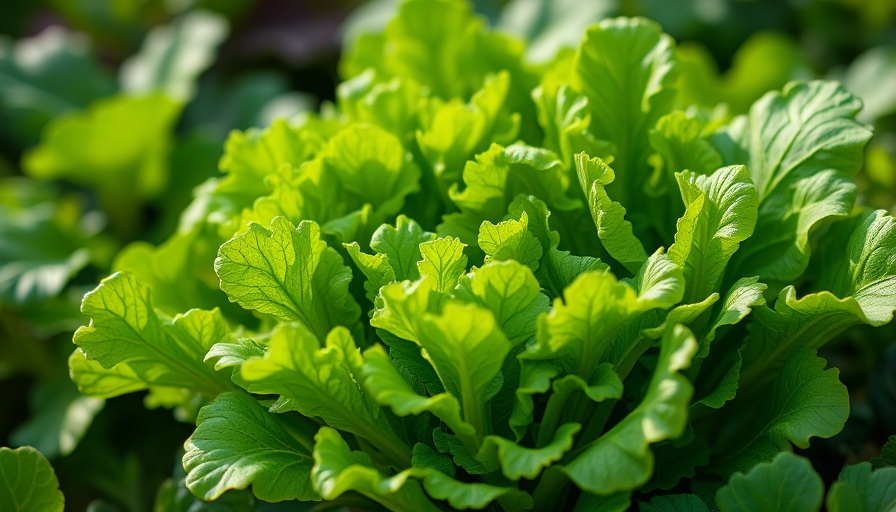
Discover the Delight of Buttercrunch Lettuce
If you’re weary of the usual lettuce staples like Iceberg and Romaine, it's time to spice up your salads with Buttercrunch lettuce! This unique variety not only offers a delightful flavor but also enhances the aesthetic of any garden with its lush, velvety leaves. As a butterhead lettuce, Buttercrunch stands out for its soft, loosely formed heads, perfect for plucking leaves for various dishes throughout the growing season.
Why Buttercrunch? The Benefits of Growing This Lettuce Variety
Buttercrunch is particularly coveted for its mild taste, making it an ideal candidate for sandwiches and wraps. Unlike many other leafy greens, it avoids the bitterness that can come as temperatures rise. This exceptional resilience places Buttercrunch at the forefront of vegetable gardening, especially in warmer climates where most lettuce varieties may struggle. Additionally, its versatility allows it to be used fresh in salads, or as a substitute in recipes needing a crunchy texture without overpowering flavors.
Quick Facts About Growing Buttercrunch Lettuce
Buttercrunch lettuce is not only easy to grow but thrives in various conditions. Here are some essential facts to keep in mind:
- Common Name: Buttercrunch lettuce
- Plant Type: Annual vegetable
- Hardiness (USDA Zone): 2-11
- Exposure: Full sun to part shade
- Soil Type: Organically rich, loose, well-draining
- Time to Maturity: 45-60 days
- Mature Size: 6-12 inches wide x 9-14 inches high
Ideal Conditions for Optimal Growth
To cultivate Buttercrunch successfully, it’s vital to provide adequate sunlight and maintain optimal soil conditions. The soil should be well-draining with a pH of 6.0-7.0. Regular watering helps maintain moisture, especially through the warm months when Buttercrunch has the potential to thrive while other varieties may begin to bolt.
Companion Planting for Buttercrunch Victory
Enhancing your garden layout through companion planting can lead to more fruitful yields. Pair Buttercrunch with herbs like basil or companion vegetables such as carrots, which can help deter pests and enhance the soil's nutrient profile. This practice not only maximizes space but contributes to the overall health of your garden ecosystem.
Harvesting Tips: When to Pick and How to Enjoy
One of the joys of growing Buttercrunch is the opportunity to begin harvesting as soon as it's ready. Picking leaves individually allows you to enjoy fresh greens throughout the season. This method also encourages continuous growth since the plant redirects energy towards growing new leaves instead of forming a complete head. Regular harvesting can extend the lifespan of your Buttercrunch lettuce and ensure a steady supply for your kitchen.
Addressing Common Pests and Diseases
As you grow your Buttercrunch, being vigilant about potential pests like aphids or diseases such as downy mildew can safeguard your harvest. Implementing organic pest control methods and maintaining clean garden practices will strengthen your plants and yield a healthier crop.
The Nutritional Benefits of Buttercrunch Lettuce
Incorporating Buttercrunch into your diet is not only tasty but nutritious. Loaded with vitamins A and K, its crunchy texture adds both flavor and health benefits to salads and other dishes. Including a variety of lettuces in your meals can also encourage diverse nutrient intake, fostering overall wellness.
Embrace Gardening for a Sustainable Choice
By choosing to grow Buttercrunch lettuce, you're investing in a sustainable practice that not only reduces carbon footprints associated with store-bought produce but also enriches your connection with nature. Urban gardening projects, even in small spaces, can create an opportunity for wholesome family activities while contributing to healthier eating habits.
Take the Leap into Gardening!
Starting a vegetable garden can seem daunting, but with simple gardening tips and a commitment to plant care, you can cultivate your healthy oasis right at home. Buttercrunch lettuce is a flavorful addition that will keep you eager for harvest season!
 Add Row
Add Row  Add
Add 




Write A Comment